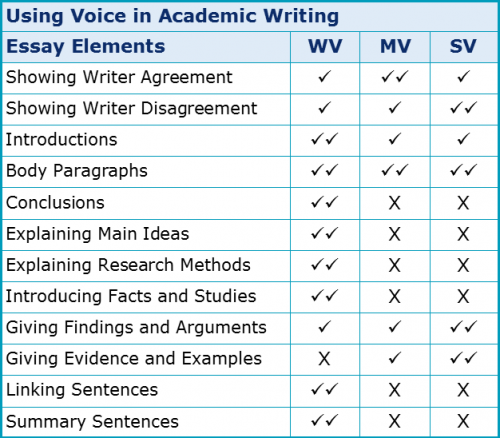How can I effectively balance ‘voice’ in my writing?

This is the third and final chapter about Balancing Voices. To complete this reader, read each chapter carefully and then unlock and complete our materials to check your understanding.
– Provide guidance on how to effectively balance ‘voice’
– Highlight the balance of voice through an example paragraph
– Use a chart to explain the twelve purposes of voice
Chapter 3
This third and final chapter on voice in academic writing deals with two aspects that should be recognised and employed by an academic. The first aspect is that an essay must have an effective balance of voice to be considered successful. To do this, a writer must also recognise the second aspect, which is that each of the three voice types are generally used for different purposes when writing academically.
1. Balancing Voice
A well-written academic essay tends to have a good balance of writer voice, mixed voice and source voice in each paragraph. Generally speaking, the writer’s voice usually accounts for about 40% of each body paragraph, with the remaining 60% being used to introduce evidence and support through mixed and source voice. Of course, for introductory and concluding paragraphs, the ratio of writer voice will be much higher as few sources are introduced outside of the body section.
To demonstrate the balance of voice in a body paragraph, we’ve included the first body paragraph from our example cause and effect essay and highlighted the writer voice in green, the mixed voice in blue and the source voice in red:
The most pedagogically valid reason that universities may have introduced preliminary year programmes is likely due to the fact that non-native students were often reported to be struggling to meet the linguistic demands of their major. In a study of 113 universities in the USA, Smith and Wesson (2000) found that dropout rates for non-native speakers of English at English-medium universities were as high as 24%. This research stimulated subsequent studies which all found that student concerns over course comprehension were a recurrent factor for these high rates (Davidson, 2001; Lee and Lee, 2004). Indeed, Johnson (2009) argues that such linguistic demands were in fact the primary reason for most cases of non-native dropouts around the turn of the millennium. In relation to this aspect, one significant effect of introducing preliminary-year programmes may be that students are now better prepared for their courses and dropout rates have decreased. In the same study, Johnson (2009) reported a decrease in dropout rates of 57% after the introduction of the preliminary year. Students have also since reported feeling more confident and comfortable with comprehending the concepts of their course (Jones, 2014), which perhaps indicates that extending bachelor’s degree programmes by a year has had a positive effect.
This paragraph has a good balance of voice, with the writer’s voice accounting for 80 of 204 words. This is roughly 39%, which is an appropriate amount for a body paragraph. The combination of mixed and source voice together is also appropriately balanced, containing roughly 61% of the total paragraph.
2. Understanding Voice Purpose
The final aspect of understanding how to balance voice is in recognising that each of the three voice types we discussed in Chapter 2 may be used for different purposes. The following table has been created to quickly demonstrate how writer voice (WV), mixed voice (MV) and source voice (SV) are generally used to introduce the various elements of an academic essay. A single tick shows that that particular voice type may sometimes be used for a certain element, a double tick shows that voice as being commonly used for an element, while a cross highlights when in that situation a particular voice type is generally unused:

Downloadables
Once you’ve completed all three chapters about voice, you might also wish to download our beginner, intermediate and advanced worksheets to test your progress or print for your students. These professional PDF worksheets can be easily accessed for only a few Academic Marks.
Collect Academic Marks
-
100 Marks for joining
-
25 Marks for daily e-learning
-
100-200 for feedback/testimonials
-
100-500 for referring your colleages/friends